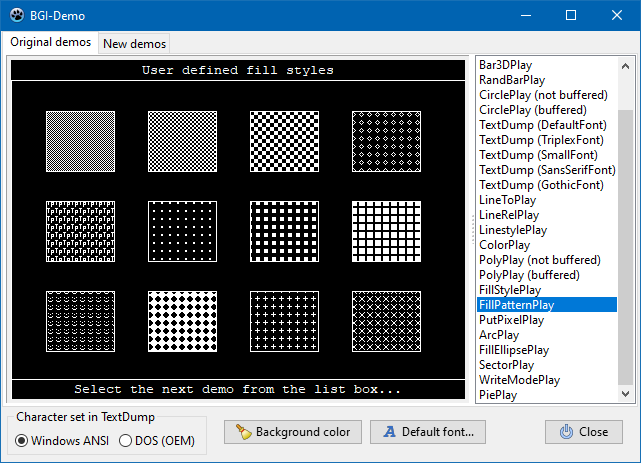Emulation of Turbo Pascal's BGI graphics commands for Lazarus
Simply copy the unit lazBGI.pas to the folder of your project.
-
Add a descendant of
TGraphicControl(TPaintbox) orTCustomControl(TPanel) to the form. A paintbox is recommended, but it is also possible to paint directly on a form. The BGI painting then is executed on the rectangle defined by this control. The top/left corner of this control has the BGI coordinates (0, 0), and the bottom/right corner has (GetMaxX,GetMaxY). -
BGI commands must begin with
InitGraph(). In contrast to BGI, the routine does not provide the graphics driver, but the canvas onto which the output is painted, e.g.Paintbox1orForm1. The other two parameters define the width and height of the drawing area:
InitGraph(Paintbox1.Canvas, Paintbox1.Width, Paintbox1.Height);-
Then the rest of the BGI commands follow like in an original ancient DOS program, such as
Line(),OutText(),Circle()etc. -
CloseGraphat the end of the graphic output is no longer absolutely required any more since the system cannot be switched back to text mode.CloseGraph, however, cleans up memory usage - it will be called automatically at the end of the program nevertheless. -
The graphics commands must be called from a routine of the painting cycle of the container control. In case of
TPaintBox,TPanelorTForm, this is theOnPaintevent. -
Note that the
OnPainthandler must be able to paint the entire control. -
In DOS, often the same function was painted over the same graphic with different parameters - this was possible because of the persistent screen memory. This is not possible any more because the OS can reqest a complete repaint at any time and thus erase the previous drawing. An exception is painting into a temporary buffer bitmap - see below.
-
Also be prepared of surprises when random numbers are used for some drawing parameters, such as in Borland's BGIDEMO.
-
The BGI painting routine, by no means, must be allowed to wait for user input like in the original BGIDEMO. User input must be handled by the usual LCL
OnKey*andOnMouse*events outside the painting routine. -
If nevertheless several curves are to be painted above each other, or if a flicker-free animation is supposed to be shown then the BGI graphic can be buffered:
- When the graph is supposed to be drawn upon a button click the drawing
commands must be put into the
OnClickevent handler of the button. The canvas for painting must be the canvas of a temporary bitmap, and the drawing routine must trigger a repaint of the control on which the BGI graphic is supposed to appear (Paintbox1.Invalidate). In theOnPainthandler of the control (Paintbox,Panel,Form, ...) the BGI graphic must be copied from the bitmap buffer to the control canvas:
- When the graph is supposed to be drawn upon a button click the drawing
commands must be put into the
var
Buffer: TBitmap;
procedure TForm1.Button1Click(Sender: TObject);
begin
FreeAndNil(Buffer);
Buffer := TBitmap.Create
InitGraph(Buffer.Canvas, Paintbox1.Width, Paintbox1.Height);
{... BGI graphics commands ... }
CloseGraph;
Paintbox1.Invalidate;
end;
procedure TForm1.Paintbox1Paint(Sender: TObject);
begin
Paintbox1.Canvas.Draw(0, 0, Buffer);
end;
procedure TForm1.FormDestroy(Sender: TObject);
begin
FreeAndNil(Buffer); // do not forget to free the buffer bitmap
end;-
Palette function are not emulated. Colors are rendered by the modern OS in a much more general way then by the BGI. Access to colors defined by constants
Black,Red,LightGrayetc is possible. More than that, colors can also be defined bySetRGBColor()andSetRGBBkColor()(for line/text and background fill, respectively). Unlike in the OS, texts are not painted in their own color, but by the line color. -
Page switching by
SetActivePage/SetVisualPageis not supported at the moment. -
Line types are displayed correctly only with line thickness 1 (NormWidth), otherwise only solid lines are shown. Unlike in the BGI, line thicknesses other than 1 (
NormWidth) or 3 (ThickWidth) can be selected. New line typeDashDotDotLn. User-defined line patterns are not supported at the moment. -
The LCL provides less fill patterns as the BGI. Therefore, all non-empty and non-solid fill patterns are emulated by means of bitmaps, in the same way as user-defined fill patterns. Moreover, a rectangle can also be filled by a linear color gradient (
GradientRect()). -
Text output uses the same fonts as the LCL, Borlands CHR vector fonts are not supported. Using
SetDefaultFont,SetTriplexFont, etc. you can define which fonts of the OS are supposed to be used instead of the BGI fonts (DefaultFont, Triplex, Small, SansSerif, Gothic), and which font sizes (in points) will be selected for the 10 BGI font sizes. Be prepared for differences to the original BGI fonts.RegisterUserFont()is not supported.InstallUserFont()is supported, however, but with different calling parameters (now allowing OS font names). Similarly every font available in the system can be used for text output by using the functionSetTextFont(). -
DrawPoly()andFillPoly()draw the connection between outer and inner polygons
